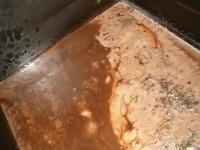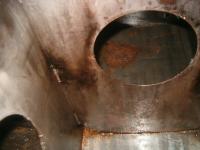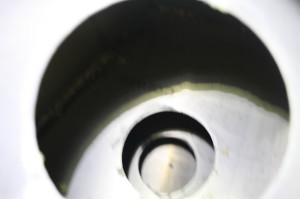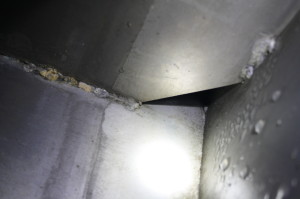
Bad fuel can come from anywhere – you can pick it up at some fuel dock or it can just sit in your tanks long enough to go bad. If dealt with in a timely manner, you can save some expense later. If not, you will need to have your tanks pumped and cleaned.

When bad fuel sits in a tank, the tank itself starts to grow algae, bacteria and other not-so-goodies on the sides and in the baffles. Also sludge will build up in the bottom of the tank. Unless you are using your boat enough to keep a constant turnover of the fuel, you should treat it on a regular basis. After the fuel gets as bad as the fuel on the right, you will need to remove it and clean the tanks.
We have a special rig with a petroleum proof / spark free motor to remove the fuel from the boat. When the fuel is this bad, we do not try to clean it – we just dispose of it. After the tank is empty the cleaning begins.

We use fresh, highly conditioned fuel to clean the tank running it in a continuous loop through the tank. We will just cycle for about 8 hours before the actual hand cleaning. The whole process is easier if there is a good sized inspection port on the tank. If we can get our hand in the tank, we use denatured alcohol and a sponge to get the sides good and clean. We also use a wet/dry vac to get all the sludge out of the bottom of the tank. Sometimes we have to tie the sponge to a stick to get into the “hard to reach corners”. The more sludge you remove, the less chance there is for the new fuel being contaminated.
One sign of water in your fuel is the presence of surface rust on the inside of the tank. We try to hit that with a bit of sandpaper – it does not harm your tank but is only on the surface.
After this kind of treatment, you will want to keep your fuel clean to avoid this measure again. We have several products we can recommend for an ongoing maintenance regime. We can also install a mechanical on-board fuel polishing system on a timer that will cycle on a regular basis through a filtration system.
?????
We Do Fuel Tank Inspections
With our specialized camera and monitor we can inspect the inside of your fuel tanks. Contact us for more information.


 Bad fuel can come from anywhere – you can pick it up at some fuel dock or it can just sit in your tanks long enough to go bad. If dealt with in a timely manner, you can save some expense later. If not, you will need to have your tanks pumped and cleaned.
Bad fuel can come from anywhere – you can pick it up at some fuel dock or it can just sit in your tanks long enough to go bad. If dealt with in a timely manner, you can save some expense later. If not, you will need to have your tanks pumped and cleaned.
 When bad fuel sits in a tank, the tank itself starts to grow algae, bacteria and other not-so-goodies on the sides and in the baffles. Also sludge will build up in the bottom of the tank. Unless you are using your boat enough to keep a constant turnover of the fuel, you should treat it on a regular basis. After the fuel gets as bad as the fuel on the right, you will need to remove it and clean the tanks.
We have a special rig with a petroleum proof / spark free motor to remove the fuel from the boat. When the fuel is this bad, we do not try to clean it – we just dispose of it. After the tank is empty the cleaning begins.
When bad fuel sits in a tank, the tank itself starts to grow algae, bacteria and other not-so-goodies on the sides and in the baffles. Also sludge will build up in the bottom of the tank. Unless you are using your boat enough to keep a constant turnover of the fuel, you should treat it on a regular basis. After the fuel gets as bad as the fuel on the right, you will need to remove it and clean the tanks.
We have a special rig with a petroleum proof / spark free motor to remove the fuel from the boat. When the fuel is this bad, we do not try to clean it – we just dispose of it. After the tank is empty the cleaning begins.
 We use fresh, highly conditioned fuel to clean the tank running it in a continuous loop through the tank. We will just cycle for about 8 hours before the actual hand cleaning. The whole process is easier if there is a good sized inspection port on the tank. If we can get our hand in the tank, we use denatured alcohol and a sponge to get the sides good and clean. We also use a wet/dry vac to get all the sludge out of the bottom of the tank. Sometimes we have to tie the sponge to a stick to get into the “hard to reach corners”. The more sludge you remove, the less chance there is for the new fuel being contaminated.
One sign of water in your fuel is the presence of surface rust on the inside of the tank. We try to hit that with a bit of sandpaper – it does not harm your tank but is only on the surface.
After this kind of treatment, you will want to keep your fuel clean to avoid this measure again. We have several products we can recommend for an ongoing maintenance regime. We can also install a mechanical on-board fuel polishing system on a timer that will cycle on a regular basis through a filtration system.
We use fresh, highly conditioned fuel to clean the tank running it in a continuous loop through the tank. We will just cycle for about 8 hours before the actual hand cleaning. The whole process is easier if there is a good sized inspection port on the tank. If we can get our hand in the tank, we use denatured alcohol and a sponge to get the sides good and clean. We also use a wet/dry vac to get all the sludge out of the bottom of the tank. Sometimes we have to tie the sponge to a stick to get into the “hard to reach corners”. The more sludge you remove, the less chance there is for the new fuel being contaminated.
One sign of water in your fuel is the presence of surface rust on the inside of the tank. We try to hit that with a bit of sandpaper – it does not harm your tank but is only on the surface.
After this kind of treatment, you will want to keep your fuel clean to avoid this measure again. We have several products we can recommend for an ongoing maintenance regime. We can also install a mechanical on-board fuel polishing system on a timer that will cycle on a regular basis through a filtration system.



